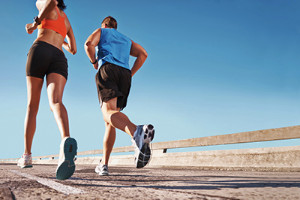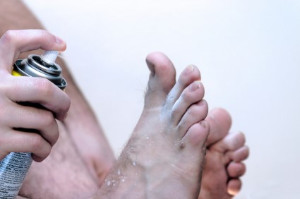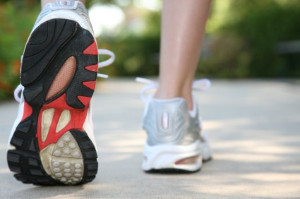Items filtered by date: June 2017
Tips for Healthy Feet
 Some of the most common complaints people have with their feet are pain, ingrown toenails, cracked heels, and fungus. When it comes to foot pain, many people are unaware that flat shoes can be just as bad as high heels. Flats do not offer any support for the foot, which can cause those who wear them to experience a lot of pain. Ingrown toenails are often the result of cutting your nails incorrectly; instead of cutting your nails in a rounded shape, you should cut them straight across. If you are trying to cure your cracked heels, you should know that they are caused by a lack of moisture in the feet. A helpful tip is to always moisturize and treat your feet the same way you would want to treat the skin on your face. If you want to get rid of toenail fungus, you should always treat it in its early stages, instead of letting it progress into something much worse. If you have any questions about any of these common foot issues, you should speak to a podiatrist right away.
Some of the most common complaints people have with their feet are pain, ingrown toenails, cracked heels, and fungus. When it comes to foot pain, many people are unaware that flat shoes can be just as bad as high heels. Flats do not offer any support for the foot, which can cause those who wear them to experience a lot of pain. Ingrown toenails are often the result of cutting your nails incorrectly; instead of cutting your nails in a rounded shape, you should cut them straight across. If you are trying to cure your cracked heels, you should know that they are caused by a lack of moisture in the feet. A helpful tip is to always moisturize and treat your feet the same way you would want to treat the skin on your face. If you want to get rid of toenail fungus, you should always treat it in its early stages, instead of letting it progress into something much worse. If you have any questions about any of these common foot issues, you should speak to a podiatrist right away.
Everyday foot care is very important to prevent infection and other foot ailments. If you need your feet checked, contact one of our podiatrists from New Tampa Foot & Ankle. Our doctors can provide the care you need to keep you pain-free and on your feet.
Everyday Foot Care
Often, people take care of their bodies, face and hair more so than they do for their feet. But the feet are a very important aspect of our bodies, and one that we should pay more attention to. Without our feet, we would not be able to perform most daily tasks.
It is best to check your feet regularly to make sure there are no new bruises or cuts that you may not have noticed before. For dry feet, moisturizer can easily be a remedy and can be applied as often as necessary to the affected areas. Wearing shoes that fit well can also help you maintain good foot health, as well as making it easier to walk and do daily activities without the stress or pain of ill-fitting shoes, high heels, or even flip flops. Wearing clean socks with closed shoes is important to ensure that sweat and bacteria do not accumulate within the shoe. Clean socks help to prevent Athlete’s foot, fungi problems, bad odors, and can absorb sweat.
If you have any questions please feel free to contact our office located in Wesley Chapel, FL . We offer the newest diagnostic and treatment technologies for all your foot and ankle needs.
How to Treat Athlete’s Foot
 Athlete’s foot is a fungal infection that occurs between the toes. Symptoms of the condition are itchy, dry, red, scaly skin that tends to worsen in the summer when the weather is humid. The infection itself is usually contracted by walking around barefoot in public areas such as locker rooms or gym showers. Treatments for athlete’s foot come in creams, sprays, liquids, and powders, and they will help stop the fungus from growing. If you have athlete’s foot, be sure to wash your feet prior to applying the treatment to the skin and surrounding area. Also, do not apply to open wounds. Contact a podiatrist for tips on how to prevent and treat athlete's foot.
Athlete’s foot is a fungal infection that occurs between the toes. Symptoms of the condition are itchy, dry, red, scaly skin that tends to worsen in the summer when the weather is humid. The infection itself is usually contracted by walking around barefoot in public areas such as locker rooms or gym showers. Treatments for athlete’s foot come in creams, sprays, liquids, and powders, and they will help stop the fungus from growing. If you have athlete’s foot, be sure to wash your feet prior to applying the treatment to the skin and surrounding area. Also, do not apply to open wounds. Contact a podiatrist for tips on how to prevent and treat athlete's foot.
Athlete’s foot is an inconvenient condition that can be easily reduced with the proper treatment. If you have any concerns about your feet and ankles, contact one of our podiatrists from New Tampa Foot & Ankle. Our doctors will treat your foot and ankle needs.
Athlete’s Foot: The Sole Story
Athlete's foot, also known as tinea pedis, can be an extremely contagious foot infection. It is commonly contracted in public changing areas and bathrooms, dormitory style living quarters, around locker rooms and public swimming pools, or anywhere your feet often come into contact with other people.
Solutions to Combat Athlete’s Foot
- Hydrate your feet by using lotion
- Exfoliate
- Buff off nails
- Use of anti-fungal products
- Examine your feet and visit your doctor if any suspicious blisters or cuts develop
Athlete’s foot can cause many irritating symptoms such as dry and flaking skin, itching, and redness. Some more severe symptoms can include bleeding and cracked skin, intense itching and burning, and even pain when walking. In the worst cases, Athlete’s foot can cause blistering as well. Speak to your podiatrist for a better understanding of the different causes of Athlete’s foot, as well as help in determining which treatment options are best for you.
If you have any questions please feel free to contact our office located in Wesley Chapel, FL . We offer the newest diagnostic and treatment technologies for all your foot and ankle needs.
Tips for Avoiding Running Injuries
 It is very important that you take precautions prior to starting your running routine. Running injuries can happen easily due to running too much too soon, or by wearing the wrong shoes. Poorly fitting running shoes have the potential to cause blisters, corns, and calluses; this is why it is advised to try on your shoes prior to wearing them to make sure they fit properly. When you are looking for a new running shoe it is important that the ball of your foot matches where the shoe bends. Furthermore, you should replace your running shoes on a regular basis. The average life of a running shoe is 350 to 500 miles, but if you are a heavy runner, you may need to replace them even sooner.
It is very important that you take precautions prior to starting your running routine. Running injuries can happen easily due to running too much too soon, or by wearing the wrong shoes. Poorly fitting running shoes have the potential to cause blisters, corns, and calluses; this is why it is advised to try on your shoes prior to wearing them to make sure they fit properly. When you are looking for a new running shoe it is important that the ball of your foot matches where the shoe bends. Furthermore, you should replace your running shoes on a regular basis. The average life of a running shoe is 350 to 500 miles, but if you are a heavy runner, you may need to replace them even sooner.
Exercising your feet regularly with the proper foot wear is a great way to prevent injuries. If you have any concerns about your feet, contact one of our podiatrists of New Tampa Foot & Ankle. Our doctors will treat your foot and ankle needs.
How to Prevent Running Injuries
Many common running injuries are caused by overuse and overtraining. When the back of the kneecap starts wearing out and starts causing pain in your knee, this is commonly referred to as runner’s knee. Runner’s knee is a decrease in strength in your quadriceps and can occur if you’re not wearing properly fitted or supporting shoes. To prevent runner’s knee, focusing on hip strengthening is a good idea, as well as strengthening your quads to keep the kneecaps aligned.
What Are Some Causes of Running Injuries?
- One cause of a common running injury is called iliotibial band syndrome.
- Plantar fasciitis is also another common injury.
- Stress fractures can occur from overtraining, lack of calcium, or even your running style.
Best Ways to Prevent Running Injuries
- Wear footwear that fits properly and suits your running needs.
- Running shoes are the only protective gear that runners have to safeguard them from injury.
- Make a training schedule. Adding strengthening exercises as well as regular stretching can help keep you strong and limber and can lessen the possibility of injuries.
- Stretching keeps muscles limber; this will help you gain better flexibility.
If you have any questions please feel free to contact our office located in Wesley Chapel, FL . We offer the newest diagnostic and treatment technologies for all your foot and ankle needs.
Signs of Poor Circulation in Your Feet
 There are a variety of causes for poor circulation in the feet, and there are dangers that come along with having it as well. Your organs and extremities can be severely affected if there is a lack of blood supply to them. Fortunately, poor circulation may be improved through dietary modifications. One of the first signs of poor circulation that you will notice is constantly cold feet. This typically happens in the winter, when your oxygenated blood has trouble reaching your lower extremities. Swelling in the feet is also a common sign of poor circulation. This happens because your body retains water around the ankles as a response to the lack of blood. This symptom should not be ignored because it can be a sign of something much more serious.
There are a variety of causes for poor circulation in the feet, and there are dangers that come along with having it as well. Your organs and extremities can be severely affected if there is a lack of blood supply to them. Fortunately, poor circulation may be improved through dietary modifications. One of the first signs of poor circulation that you will notice is constantly cold feet. This typically happens in the winter, when your oxygenated blood has trouble reaching your lower extremities. Swelling in the feet is also a common sign of poor circulation. This happens because your body retains water around the ankles as a response to the lack of blood. This symptom should not be ignored because it can be a sign of something much more serious.
Poor circulation is a serious condition and needs immediate medical attention. If you have any concerns with poor circulation in your feet contact one of our podiatrists of New Tampa Foot & Ankle. Our doctors will treat your foot and ankle needs.
Poor Circulation in the Feet
Poor blood circulation in the feet and legs is can be caused by peripheral artery disease (PAD), which is the result of a buildup of plaque in the arteries.
Plaque buildup or atherosclerosis results from excess calcium and cholesterol in the bloodstream. This can restrict the amount of blood which can flow through the arteries. Poor blood circulation in the feet and legs are sometimes caused by inflammation in the blood vessels, known as vasculitis.
Causes
Lack of oxygen and oxygen from poor blood circulation restricts muscle growth and development. It can also cause:
- Muscle pain, stiffness, or weakness
- Numbness or cramping in the legs
- Skin discoloration
- Slower nail & hair growth
- Erectile dysfunction
Those who have diabetes or smoke are at greatest risk for poor circulation, as are those who are over 50. If you have poor circulation in the feet and legs it may be caused by PAD and is important to make changes to your lifestyle in order to reduce risk of getting a heart attack or stroke. Exercise and maintaining a healthy lifestyle will dramatically improve conditions.
As always, see a podiatrist as he or she will assist in finding a regimen that suits you. A podiatrist can also prescribe you any needed medication.
If you have any questions please feel free to contact our office located in Wesley Chapel, FL . We offer the newest diagnostic and treatment technologies for all your foot and ankle needs.
